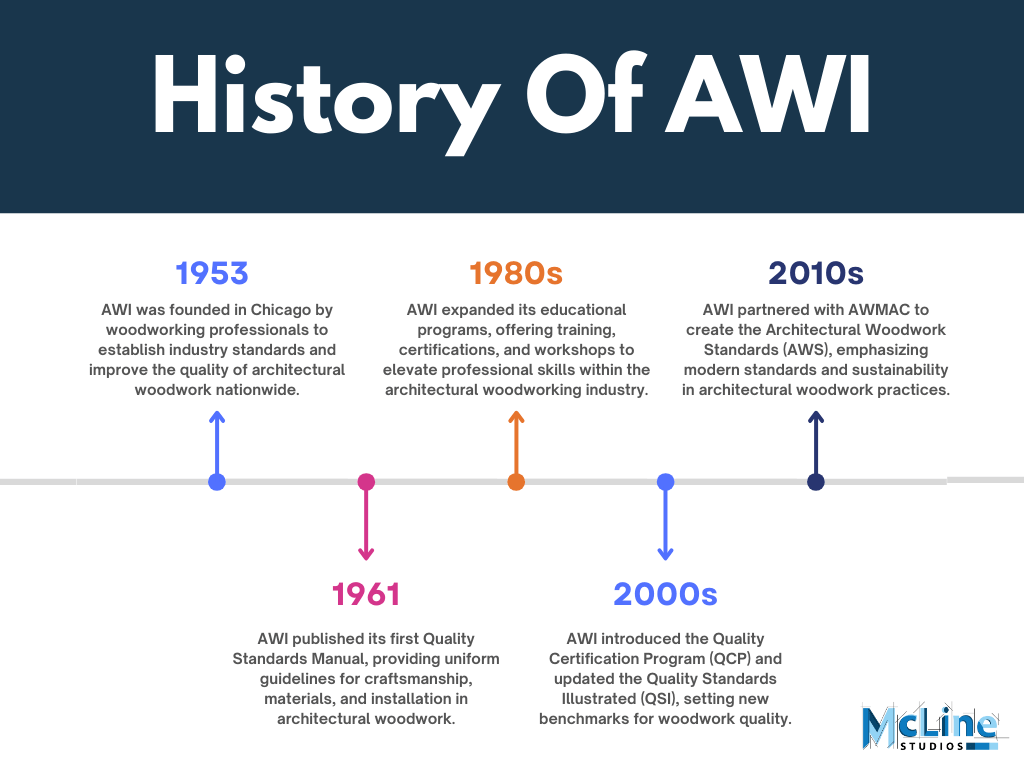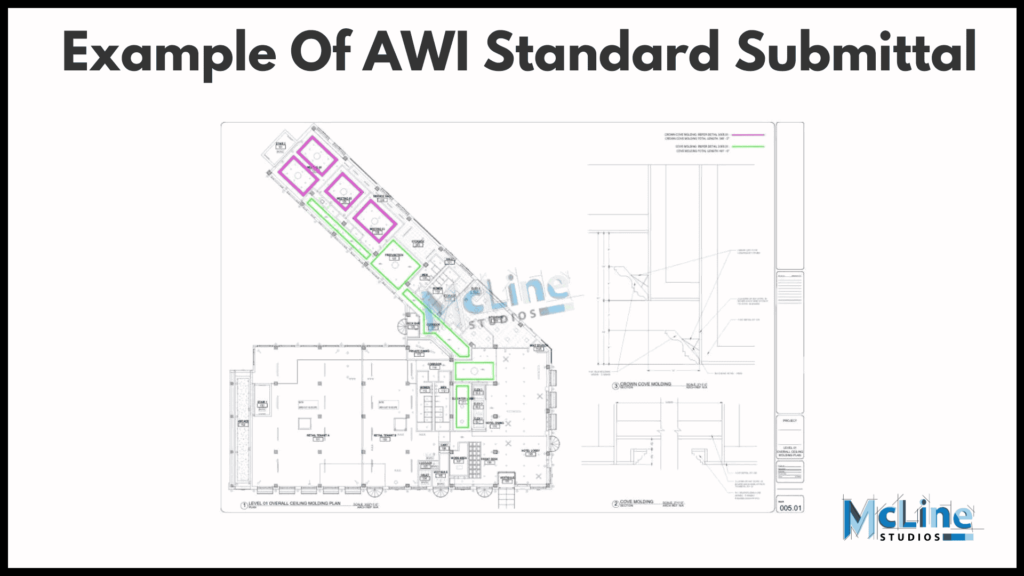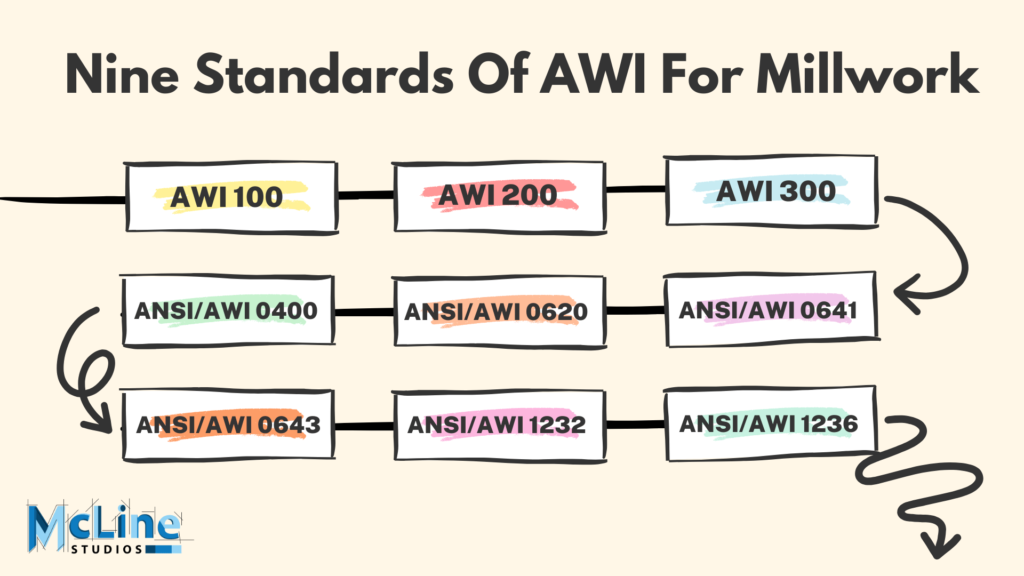The organization called AWI (Architectural Woodwork Institute) sets the standards for quality and craftsmanship in the millwork industry. These guidelines serve as a benchmark for architects, contractors, and woodworkers.
Think of these standards as a set of rules that help maintain high quality across all woodwork projects. They make sure the finished product is not only beautiful but also durable and functional. These standards provide consistency and excellence in the production of custom wood products like cabinetry, trim, and other interior finishes.
In these standards, AWI outlines the best practices for delivering top-quality architectural woodwork. These standards are designed to guide woodworkers, contractors, and architects to ensure that the result meets the expectations of quality, aesthetics, and functionality.
There are nine AWI standards in total, which we will be discussing in this guide. AWI standards cover every stage of the millwork process, from the design and selection of materials to fabrication and installation.
Let’s begin!
History Of AWI Standards
In 1961, AWI released its first set of guidelines called “Quality Standards.” These rules covered how to make and install different wood products. Over time, these guidelines became more detailed, covering everything from materials to finishes.

As woodworking techniques and technology improved, AWI kept updating its standards. In 2003, AWI introduced the “Architectural Woodwork Standards” (AWS), which expanded on their earlier guidelines. AWS brought together several different industry groups, making the standards more widely accepted.
Now in the 2010s, AWI introduced a performance-based approach to their standards, meaning they focused more on how well the finished product functions rather than just how it looks. This shift helps that woodwork not only looks good but also performs well over time.
List Of All AWI Standards For Millwork
- AWI 100 – Submittals
- AWI 200 – Care & Storage
- AWI 300 – Materials
- ANSI/AWI 0400 – Factory Finishing
- ANSI/AWI 0620 – Finish Carpentry/Installation
- ANSI/AWI 0641 – Architectural Wood Casework
- ANSI/AWI SMA 0643 – Wood Stair, Handrail, and Guard Systems
- ANSI/AWI 1232 – Manufactured Wood Casework
- ANSI/AWI 1236 – Countertops
AWI 100 – Submittals
AWI 100 is the starting point for any millwork project, focusing on the submittals required before the work begins. Submittals are documents that provide essential information to all parties involved in the project, such as architects, contractors, and clients.
These documents confirm that everyone is on the same page before fabrication or installation begins.
Components Of AWI 100
- Shop Drawings: These are highly detailed blueprints that showcase the design, construction methods, materials, and installation of millwork elements. They help verify that the woodwork is fabricated according to project specifications.
- Product Data: This includes detailed specifications of materials such as the type of wood, finishes, hardware, and other components used in the project. It provides insight into the quality and aesthetic expectations.
- Samples: Physical examples of materials and finishes are provided to illustrate the exact look and feel of what will be installed.
- Approvals: This stage involves stakeholders reviewing and approving the shop drawings, material data, and samples. The approval process guarantees that the design intent and material specifications meet project expectations.
Best Practices
- Always submit accurate and detailed shop drawings to make sure they match the architectural design.
- Submit material samples as early as possible to allow sufficient time for review and approval.
- Consistently communicate with all stakeholders during the submittal process to avoid misunderstandings and delays.
For detailed information, visit here.

AWI 200 – Care & Storage
AWI 200 provides critical guidelines for the proper care and storage of wood materials throughout a project’s lifecycle. Wood is a natural material that reacts to environmental changes. This makes it vulnerable to issues like warping, splitting, or moisture absorption if not handled correctly.
This standard guarantees that wood maintains its integrity and quality from the moment it is received until installation is complete.
Components Of AWI 200
- Environmental Controls: AWI 200 outlines specific requirements for maintaining optimal temperature and humidity levels to protect wood from environmental damage. These controls help prevent issues like warping, swelling, or drying out caused by extreme or fluctuating conditions.
- Storage Practices: Proper storage methods are emphasized, including recommendations to store wood in climate-controlled environments. This assures the materials remain stable and unaffected by external conditions, preserving their quality before installation.
- Handling Guidelines: Careful handling of wood materials is essential to prevent physical damage. AWI 200 provides guidelines on how to transport and handle wood safely, reducing the risk of scratches, dents, or other structural defects during the moving and installation process.
Best Practices
- Store wood in climate-controlled conditions to protect it from environmental changes.
- Acclimate wood products to the project environment before installation to prevent dimensional changes once installed.
- Follow recommended handling procedures to avoid accidental damage during transport and installation.
For detailed information, visit here.
AWI 300 – Materials
AWI 300 sets the standard for selecting materials used in architectural woodwork. With the help of these standards, woodworkers choose the best-suited materials for each project based on factors like durability, aesthetics, and functionality. This standard helps that the finished product not only meets design expectations but also performs well under various conditions.
Components Of AWI 300
- Lumber: AWI 300 covers the selection of both hardwoods and softwoods for different applications. Hardwoods like oak, maple, and cherry are often chosen for their strength and visual appeal, while softwoods like pine may be used in less demanding applications.
- Sheet Goods: This includes specifications for materials like plywood, MDF (medium-density fiberboard), and high-pressure decorative laminates (HPDL). These materials are often used for cabinetry, paneling, and other woodwork due to their versatility and stability.
- Veneers: AWI 300 guides on selecting wood veneers based on characteristics such as grain pattern, color, and overall quality. Veneers offer a way to achieve a high-end appearance while using less expensive core materials.
Best Practices
- Use strong, durable hardwoods in high-traffic or high-impact areas for longevity.
- Choose materials with moisture and environmental resistance, especially in areas exposed to humidity or temperature changes.
- Select veneers carefully to confirm color consistency and grain matching for a polished, professional look.
For detailed information, visit here.
ANSI/AWI 0400 – Factory Finishing
ANSI/AWI 0400 provides guidelines for the factory finishing of wood products, providing a controlled process for applying finishes such as stains, varnishes, and sealants.
By completing the finishing in a factory setting, the standard provides a higher level of consistency and quality, as environmental factors like dust, humidity, and temperature are closely regulated.
Components Of ANSI/ AWI 0400
- Finishing Techniques: This standard covers various types of finishes, including lacquer, varnish, and water-based coatings, each chosen based on the project’s aesthetic and durability requirements. The right finish improves both the appearance and protection of the wood.
- Surface Preparation: ANSI/AWI 0400 focuses on the importance of thorough surface preparation before applying any finish. Sanding and priming the wood confirms that the surface is smooth and ready for an even, high-quality application of the finishing material.
- Performance Characteristics: The finishes must protect the wood from environmental factors such as moisture, wear, and damage over time. This provides the longevity and durability of the wood, making it suitable for various applications, from furniture to architectural woodwork.
Best Practices
- Selecting the right finish for durability and long-term protection is essential. This provides the wood is shielded from damage and retains its look over time.
- Before applying any finish, make sure that all surfaces are carefully sanded and primed to avoid any imperfections or uneven coatings.
For detailed information, visit here.
ANSI/AWI 0620 – Finish Carpentry/Installation
ANSI/AWI 0620 outlines standards for the proper installation of finished wood products, confirming that they are installed accurately, securely, and aesthetically. This standard is essential for maintaining the integrity, appearance, and functionality of woodwork during and after installation.
Components Of ANSI/AWI 0620
- Casework Installation: ANSI/AWI 0620 provides detailed guidelines for the installation of casework, including cabinets, shelves, and other wood products. The focus is on precision and stability so that these elements are securely anchored and function as intended.
- Trim and Molding: This section covers the proper methods for installing decorative elements such as running trims, standing trims, and other moldings. The correct installation of these features enhances the overall aesthetic and contributes to the architectural detailing of the space.
- Tolerances: ANSI/AWI 0620 establishes acceptable limits for gaps, alignment, and levelness. These tolerances provide a high-quality finish, preventing visual defects or functional issues that could arise from misalignment or improper installation.
Best Practices
- Accurate measurements during installation are essential to achieving perfect alignment and a seamless fit between different wood components.
- Adhering to specific manufacturer instructions for attaching trims and casework makes sure that the materials are installed correctly without causing damage.
For detailed information, visit here.
ANSI/AWI 0641 – Architectural Wood Casework
ANSI/AWI 0641 provides standards for the construction and installation of architectural wood casework, including cabinets, drawers, and shelving units. Casework should meet both functional and aesthetic requirements, making it suitable for various residential and commercial applications where durability and design are essential.
Components Of ANSI/AWI 0641
- Design Requirements: ANSI/AWI 0641 specifies load-bearing capacity, moisture resistance, and overall durability to confirm that the casework is suitable for its intended use. These guidelines help maintain structural integrity while also addressing the need for long-term performance.
- Materials and Construction: The standard guides on selecting wood types, joinery methods, and construction techniques so that the casework is strong and built to last. Attention to detail during construction, such as choosing the right materials and using proper methods.
- Finishing: Proper finishing not only enhances the appearance of the casework but also protects it from moisture, wear, and other environmental factors.
Best Practices
- For casework that will experience heavy use, such as kitchen cabinets or office storage units, it is important to use strong, durable materials like hardwoods or high-quality engineered woods.
- Making sure that all edges and corners are properly finished helps prevent wear and tear, especially in high-traffic areas where the casework is frequently opened or touched. This also adds to the longevity and aesthetic appeal of the casework.
For detailed information, visit here.
ANSI/AWI SMA 0643 – Wood Stair, Handrail, and Guard Systems
ANSI/AWI SMA 0643 provides guidelines for the design, fabrication, and installation of wood staircases, handrails, and guardrails. This standard provides both safety and aesthetics. They should be prioritized in stair construction, balancing structural integrity with visual appeal.
Components Of ANSI/AWI SMA 0643
- Dimensional Requirements: The standard covers the specific dimensions that stairs, handrails, and guardrails must meet to comply with safety codes and ergonomic standards. These dimensions make sure that staircases are safe and comfortable to use, adhering to building regulations for height, width, and spacing.
- Structural Integrity: ANSI/AWI SMA 0643 sets out guidelines to confirm that wood stair systems are strong and durable. It focuses on the materials, joinery, and installation techniques that help the stairs withstand daily use and maintain their integrity over time.
- Aesthetic Considerations: This standard also emphasizes the importance of ensuring that stair and handrail designs complement the overall architectural theme of the space. The balance between safety and visual design is key to creating a cohesive and attractive environment.
Best Practices
- Hardwoods like oak or maple are recommended for stairs, as they provide strength and durability, making the stair system capable of withstanding heavy daily use.
- Accurate measurements for handrails and guardrails are essential to meet safety codes and create a secure environment for users.
For detailed information, visit here.
ANSI/AWI 1232 – Manufactured Wood Casework
ANSI/AWI 1232 sets the standards for manufactured wood casework, focusing on the production of mass-manufactured cabinets, shelves, and other casework products that are fabricated in factories and then assembled on-site. This standard ensures that mass-produced wood casework meets high standards of durability, functionality, and aesthetics.
Components Of ANSI/AWI 1232
- Specifications: ANSI/AWI 1232 outlines minimum requirements for dimensions, moisture resistance, and load-bearing capacities. These specifications confirm that manufactured casework can endure the demands of everyday use, especially in high-traffic or moisture-prone areas.
- Construction Techniques: The standard provides guidelines for the assembly, joinery, and installation processes. Proper construction techniques are essential for maintaining the structural integrity of the casework over time.
- Aesthetic Requirements: In addition to functionality, ANSI/AWI 1232 emphasizes the importance of making sure that manufactured casework meets design specifications. This includes considerations for appearance, such as finishes, color consistency, and alignment, which contribute to the overall visual quality of the casework.
Best Practices
- It is critical to follow precise specifications for moisture resistance and load capacities, particularly in areas where the casework will face higher levels of stress or exposure to humidity.
- Proper assembly and installation are key to avoiding gaps, misalignments, or other defects that could affect both the appearance and functionality of the casework.
For detailed information, visit here.

ANSI/AWI 1236 – Countertops
ANSI/AWI 1236 sets forth the standards for fabricating and installing countertops, providing that they are durable, visually appealing, and able to withstand the wear and tear of everyday use. Countertops, as one of the most heavily used surfaces in both residential and commercial settings, require careful attention to material selection, construction, and finishing.
Components Of ANSI/AWI 1236
- Material Options: ANSI/AWI 1236 guides on selecting materials for countertops, including wood, laminate, solid surfaces, and engineered stone. The choice of material depends on the intended use, aesthetic preferences, and environmental factors like moisture or heat exposure.
- Construction Techniques: This standard emphasizes the importance of sturdy construction and proper assembly. Strong understructures and joinery techniques are critical for preventing sagging or structural failure over time.
- Finishing: ANSI/AWI 1236 outlines best practices for sealing and finishing countertops. Proper finishing protects countertops from damage caused by moisture, heat, and daily wear, preserving both their functionality and appearance.
Best Practices
- In areas near sinks, dishwashers, or other water sources, it is crucial to select materials that can resist moisture damage. Laminate and engineered stone are often preferred for their durability and resistance to water.
- Countertops should be supported by solid understructures to prevent sagging, especially in areas where they will hold heavy objects or appliances. Proper support extends the lifespan of the countertop and prevents damage.
For detailed information, visit here.
Summary
In summary, the Architectural Woodwork Institute (AWI) sets essential standards for quality in the millwork industry to ensure that wooden features like cabinetry and trim are both beautiful and durable.
First introduced in 1961 as “Quality Standards,” these guidelines have evolved into the “Architectural Woodwork Standards” (AWS), focusing on both appearance and performance. In the modern era, AWI set up the nine prominent standards for the millwork industry.
AWI 100, AWI 200, AWI 300, ANSI/AWI 0400, ANSI/AWI 0620, ANSI/AWI 0641, ANSI/AWI SMA 0643, ANSI/AWI 1232, and ANSI/AWI 1236 are these nine standards. These standards collectively assure that architectural woodwork projects are completed with high quality and consistency.
If you’re looking for AWI standards millwork shop drawings then reach out to us at info@mclinestudios.com or call us at +1-(302)-364-0899.
Reference: https://awinet.org/standards/




